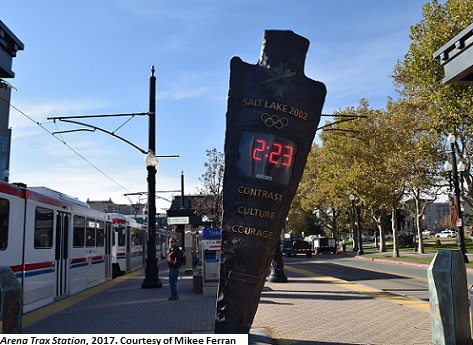Dublin Core
Title
Description
The unique discovery of an ancient Fremont Village in the heart of downtown Salt Lake City tells a story of a time before Utah was settled by European pioneers.
Thousands of people ride the Trax line through downtown Salt Lake City every day. As they pass over the intersection of South Temple and 300 West, few realize they are riding over a major archaeological discovery.
During the construction of the Trax line in 1999, a worker noticed odd items in a trench and called in the State Archaeologist, who identified them as human bone fragments. Work was halted while archaeologists uncovered the nearly complete skeleton of a Native American man. The grave was excavated in consultation with Native American Tribes, and analysis showed that the bones were those of a male in his sixties, who suffered severe arthritis, ate a lot of corn, and lived more than 1000 years ago.
Archaeological sites are not uncommon in Utah, but unearthing this human burial in downtown Salt Lake was a significant discovery. Further excavation by a research team from Brigham Young University uncovered several ancient pit houses, storage pits, fire hearths, and thousands of artifacts dating to 1000 years ago. Pottery, bone needles, arrow points and corn grinding tools provide clues about the Fremont people who lived at this spot. Animal bones found at the site, such as deer, rabbit, bison, and fish, provide information about the foods they ate and the surrounding environment. For example, the fish bones belonged to a minnow that probably came from what is now called City Creek, which flowed adjacent to this prehistoric village.
How many other Fremont villages lie beneath the modern hustle and bustle of Salt Lake? Archaeologists don’t know, but there are likely many such sites along the Wasatch Front. Records from the earliest Mormon Pioneers mention prehistoric sites from Brigham City south to St. George. For thousands of years, Native Americans found the Wasatch Front appealing for the very same reasons the pioneers did. Water, game, shelter, and soils suitable for farming, made this area attractive for settlement long before 1847.
Creator
Source
Image: Arena Trax Station, 2017. When this Trax station was built, numerous remains were discovered by construction workers. This statue was built as a countdown to the Olympics, but was built as an arrowhead to recognize the Fremont remains underneath the Trax station. Courtesy of Mikee Ferran.
_______________
See Rood, Ronald J. and Kevin T. Jones, 2002 Initial Archaeological Investigations at 42SL285, Downtown Salt Lake City, Utah, Report submitted to Utah Transit Authority by Utah Division of State History, Archaeology/Antiquities Section, Salt Lake City, UT, 2002.

